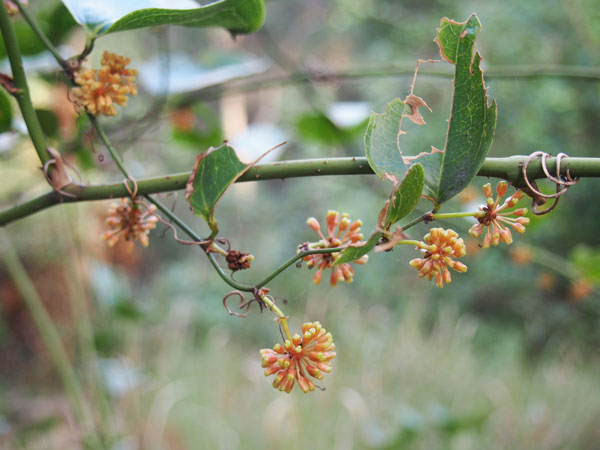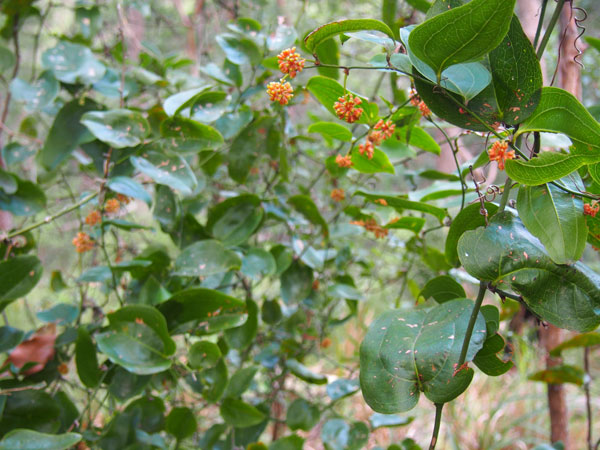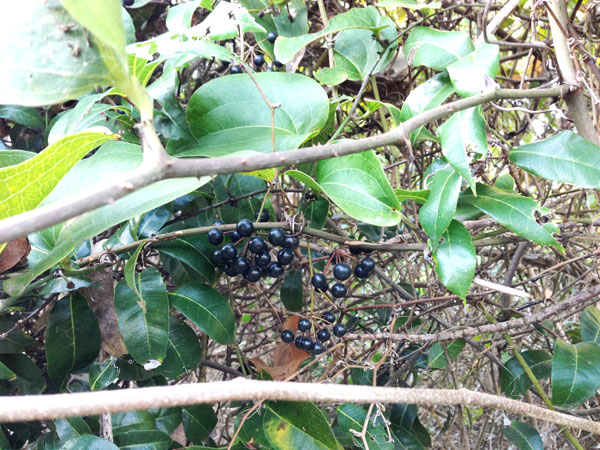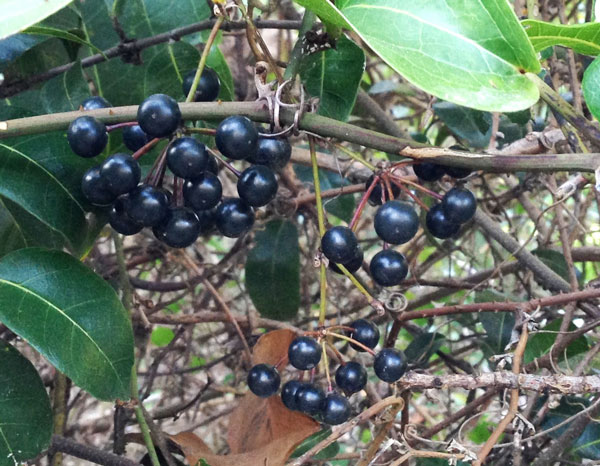Following on from the article on Cockspur Thorn (Maclura cochinchinensis) in the July 2015 edition, we continue the thorny theme with another prickly customer, Barbed-wire Vine or Smilax (Smilax australis). Like Cockspur Thorn, this is another native vine very common to most environments across South East Queensland. It is found anywhere from littoral rainforests to open eucalypt forests and even in heathland.
A day in the bush wearing shorts often seems to result in scratched and bloody lower legs. Smilax is usually the culprit and is a good reminder to wear appropriate clothing! Despite this, I still sometimes wear shorts in the height of summer only to pay for it with scratches that sting for a number of days. Perhaps a small price to pay for spending a pleasant day in the bush?
Although there are some annoying points (pun intended) to this and other spiky vines, they are hugely outweighed by the positives they provide in their environments. Smilax alone provides habitat for many different species. Its round black fruit are eaten by birds such as the Satin Bowerbird and Green Catbird, while the leaves are food for caterpillars of the impressively-named Erebus Moth (Erebus terminitincta) and three species of butterfly: the Fiery Jewel (Hypochrysops ignita), Bright Forest-blue (Pseudodipsas cephenes) and Coral Jewel (Hypochrysops miskini).


Smilax in flower

A scrambling thicket of Smilax

Shiny, black Smilax fruit
Clusters of individual cream-tubular flowers of Smilax attract a myriad of insects, especially butterflies. Most importantly, like all of its other spiky friends, Smilax provides great cover and protection for many animals. Its ability to form impenetrable thickets makes it an ideal hiding and nesting place for birds, particularly Eastern Whipbirds. Smilax also scrambles through and over small bushes and shrubs, providing great shade with its large leathery leaves. Wallabies make good use of such spots on hot days.
These spiky vines sometimes get a bad rap when they interrupt a peaceful walk through a bushland property. But every native plant has its role in nature, no matter how big or small (or annoying) it may be. My advice for those who dislike these thorny locals is to trim, tie back or re-direct the vines away from access tracks, particularly where they are at face level. Away from tracks, vines should be left alone to do what they do best – scramble and climb throughout the bush.
If you are weeding, then wearing shoes, long pants, a long sleeve shirt, gloves and safety glasses are a good way to avoid being scratched. If you treat these spiky vines as friends not foes, your local fauna will definitely thank you for it.
Article and photographs by Cody Hochen Land for Wildlife Officer Brisbane City Council

Thank you for this article. We often buy plants from the Kumbartcho Plant Nursery near Brisbane and we get them home and never know what we have in our garden. Problems arise when we get weeds growing and we are not sure if the plants is, as you say, friend or foe. It is lovely to know this is a good one to keep. We love our butterflies and birds. I’ve bookmarked your site and intend to explore more of it.Thanks again.Merril and Peter.
Where it is growing out in the open on cattle grazing land (sometimes in thickets 20m across & nothing grows within), how can I control this plant please?.
Hi Russell. The Land for Wildlife program is about provide habitat for native wildlife, so we would encourage you keep the Smilax as habitat for small birds and reptiles like skinks, rather than control it.
I am clearing lantanna along a dry creek bed and the smilax is very thick in some areas. Can there be too much?
I am currently clearing lantana along a dry creek bed and have found that smilax is growing over the lantana and dominating the growth along this causeway. I had cleared the lantana along a higher level and found the smilax was not so invasive and appeared to have a more balanced presence. should I thin it out (and if so how) or should I just leave it and hope it doesn’t swallow everything up. Length of creekbed being cleared is about 400 metres.
Hi Janette. Good on you for clearing lantana. Smilax can sometimes can very dense. If you think it is so dense that it is smothering the growth of native seedlings underneath, you may wish to cut it back, especially to free up space for native tree seedlings. If you don’t need to access the area and don’t mind its density, you can just leave it as is. Dense Smilax tangle is great habitat for small birds and lizards and eventually, over time, trees will grow up around it and shade it out. Alternatively, join Land for Wildlife (if your property is eligible) and have a LfW Officer visit your property and discuss it with them.